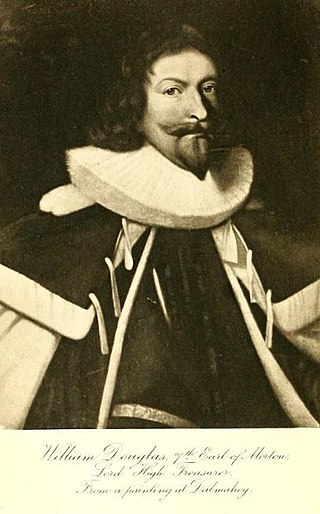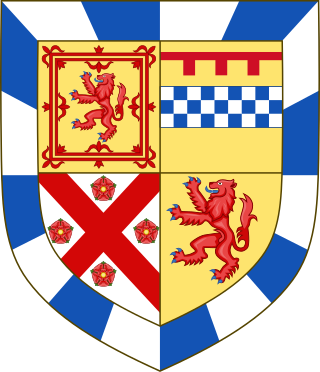

William Compton, 1st Earl of Northampton, KG (died 24 June 1630), known as 2nd Baron Compton from 1589 to 1618, was an English nobleman, peer, and politician.


William Compton, 1st Earl of Northampton, KG (died 24 June 1630), known as 2nd Baron Compton from 1589 to 1618, was an English nobleman, peer, and politician.
Northampton was the son of Henry Compton, 1st Baron Compton, and Frances Hastings. His maternal grandparents were Francis Hastings, 2nd Earl of Huntingdon and Catherine Pole. Catherine was a daughter of Henry Pole, 11th Baron Montacute and Lady Jane Nevill. Jane was in turn a daughter of George Nevill, 4th Baron Bergavenny and his wife Margaret, daughter of Hugh Fenn.
In June 1590 he went to Edinburgh with Edward Somerset, 4th Earl of Worcester to congratulate James VI on his marriage to Anne of Denmark. Compton watched 'pastimes' on the sand of Leith. [1]
At the Union of the Crowns, in May 1603, Compton and others including Francis Norris and the Earl of Lincoln were sent by the Privy Council to Berwick-upon-Tweed to meet Anne of Denmark. On the way, they heard reports that she was delayed and unwell at Stirling Castle. There were (unfounded) rumours of plague at Berwick. Compton wrote to Lord Cecil that Lady Kildare had gone to Edinburgh alone. [2]
He notably served as Lord Lieutenant of Warwickshire and of Gloucestershire and as Lord President of the Marches and of the Dominion of Wales. In 1618 he was created Earl of Northampton.
Lord Northampton married in 1599 or 1600 Elizabeth Spencer, a daughter of Sir John Spencer who had been Lord Mayor of London in 1594. [3] Their children included:
In March 1610 Elizabeth's father died leaving a fortune, and a letter (purportedly) sets out her expectations from her husband. These included; £1,600 per year and £600 for charitable works; three horses of her own; two gentlewomen attendants and horses for them; six or eight gentlemen; two coaches one for herself and another for her women each with a coachman and four horses, with carriages and carts for her things; twenty new gowns yearly; new furnishings in their houses including couches and canopies for her drawing chambers; he should finish building Castle Ashby House; and more signed "Eliza Compton". [4]
William Compton was a participant in the Accession Day tilts or tournaments at the royal court from 1589. When Prince Henry was made Prince of Wales in 1610, William distinguished himself at the tournament. He dressed as a shepherd knight and sat in a specially constructed "mount" or bower to accept challenges. An eyewitness reported:
He builded himself a bower upon the top of the wall next to St. James's Park, made in the manner of a sheepcote, and there he sat in a gray russet cloak and had a sheep crook in one hand as though he had been a shepherd, and through the top of the bower there stood up the mast of a ship gilded with gold and upon the top a pan with fire burning in it, as some thought with pitch and an iron mark to mark sheep. ...
Afterward, my Lord Compton descended from his sheepcote and mounted himself on a lofty steed, his men also attending him on horseback, every one wearing a hat of straw and their faces painted as black as the devil. [5]
The shepherd's bower was designed by Inigo Jones. The historian Roy Strong identifies this performance as a revival of Elizabethan pastoral themes, related to the shepherd knight Phillisides of Philip Sydney's Arcadia [6]
Lord Compton ordered a suit of plate armour from the Royal Greenwich Workshop around 1588, and was depicted wearing it in his only known portrait. The armour was depicted as having been heat blued and decorated with gold leaf. A team of researchers including blacksmith Ric Furrer and armourer Jeff Wasson reproduced the cuirass and placard of Lord Compton's armour for a 2017 Nova episode, "Secrets of the Shining Knight", and successfully tested it against a shot from a matchlock musket. [7]

Marquess of Northampton is a title that has been created twice, firstly in the Peerage of England (1547), then secondly in the Peerage of the United Kingdom (1812). The current holder of this title is Spencer Compton, 7th Marquess of Northampton.

Edward Somerset, 4th Earl of Worcester, KG, Earl Marshal was an English aristocrat. He was an important advisor to King James I, serving as Lord Privy Seal.

Thomas Howard, 1st Earl of Suffolk,, of Audley End House in the parish of Saffron Walden in Essex, and of Suffolk House near Westminster, a member of the House of Howard, was the second son of Thomas Howard, 4th Duke of Norfolk, by his second wife Margaret Audley, the daughter and eventual sole heiress of Thomas Audley, 1st Baron Audley of Walden, of Audley End.

Spencer Compton, 2nd Earl of Northampton, styled Lord Compton from 1618 to 1630, was an English soldier and politician who sat in the House of Commons from 1621 to 1622. He became a peer by writ of acceleration in 1626 and by inheritance in 1630. He fought in the Royalist army and was killed in action at the Battle of Hopton Heath.

Thomas Sackville, 1st Earl of Dorset was an English statesman, poet, and dramatist. He was the son of Richard Sackville, a cousin to Anne Boleyn. He was a Member of Parliament and Lord High Treasurer.

William Douglas, 7th Earl of Morton was a grandson of the 6th Earl of Morton. He was Treasurer of Scotland, and a zealous Royalist.

John Erskine, 2nd Earl of Mar was a Scottish politician, the only son of another John Erskine and Annabella Murray. He is regarded as both the 19th earl and the 2nd earl.

George Home, 1st Earl of Dunbar, KG, PC was, in the last decade of his life, the most prominent and most influential Scotsman in England. His work lay in the King's Household and in the control of the State Affairs of Scotland and he was the King's chief Scottish advisor. With the full backing and trust of King James he travelled regularly from London to Edinburgh via Berwick-upon-Tweed.

Sir George Clifford, 3rd Earl of Cumberland, 13th Baron de Clifford, 13th Lord of Skipton,, was an English peer, naval commander, and courtier of Queen Elizabeth I of England. He was notable at court for his jousting, at the Accession Day Tilts, which were highlights of the year at court. Two famous survivals, his portrait miniature by Nicholas Hilliard and a garniture of Greenwich armour, reflect this important part of his life. In contrast, he neglected his estates in the far north of England and left a long succession dispute between his heirs.

Baron Compton is an abeyant title in the Peerage of England, meaning that inheritance of the title stopped because there was no legal priority as to which daughter would inherit the title. The title was created in 1572 for the Tudor politician, Sir Henry Compton. In 1618, his son was created Earl of Northampton. The titles remained united until the fifth earl died without any male heirs in 1754 and the title passed to his only daughter, Charlotte, who had already inherited the title of Baroness Ferrers of Chartley from her mother in 1740. Charlotte was the wife of Hon. George Townshend, who became Viscount Townshend in 1764 and was created Marquess Townshend after her death in 1770. The title then remained with the marquessate until her grandson, the third marquess, died childless in 1855 and both baronies became abeyant between his sisters and their descendants.
Henry Nevill, de facto 9th Baron Bergavenny was an English iron founder, soldier and politician who sat in the House of Commons at various times between 1601 and 1622 when he inherited the Baron Bergavenny peerage.

William George Spencer Scott Compton, 5th Marquess of Northampton, KG, known as Lord William Compton from 1877 to 1887 and as Earl Compton from 1887 to 1897, was a British peer and Liberal politician.
Henry Compton, 1st Baron Compton, was an English peer and Member of Parliament.

William Spencer, 2nd Baron Spencer of Wormleighton was an English nobleman, politician, and peer from the Spencer family.
John Carey, 3rd Baron Hunsdon was an English peer, politician and Governor of Berwick-upon-Tweed.

Andrew Stewart, 2nd Lord Ochiltree fought for the Scottish Reformation. His daughter married John Knox and he played a part in the defeat of Mary, Queen of Scots at the battle of Langside.
Hon. Sir Edward Herbert of Powis Castle was an English politician and landowner. His aunt, Katherine Parr, was the sixth, and final, wife of King Henry VIII.

Anne Sackville, Countess of Dorset, née Anne Spencer, was the second wife of Robert Sackville, 2nd Earl of Dorset. Dorset was her third husband, the first two being William Stanley, 3rd Baron Monteagle, and Henry Compton, 1st Baron Compton, both of whom predeceased her.

Frances Howard, Countess of Kildare, was a courtier and governess of Princess Elizabeth Stuart, Queen of Bohemia, and a member of the House of Howard.
William Bowyer was an English soldier, administrator, and Captain of the garrison at Berwick-upon-Tweed.